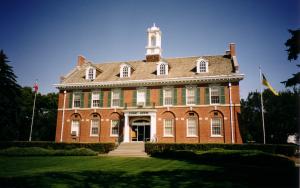
City, pop 9,433 (2006c), 9,534 (2001c), is located on the Souris River 115 km southeast of Regina, 86 km northwest of Estevan, and 75 km north of the Canada-United States border at the junction of Hwys 13, 35, and 39. Settlement of the region was made possible by the completion of two rail lines: in 1892, the CPR completed their line from Brandon, Manitoba to Estevan, and in 1893 the railway finished the “Soo Line” through North Portal to Moose Jaw, the latter line running through the site of present-day Weyburn. The line from the east brought settlers from eastern Canada, mainly Ontario; the line from the south brought many up from the United States, particularly after 1900. An early homesteader, William Hunt, established the Weyburn Post Office on August 1, 1895; although various theories exist, the origin of the name is unknown. In the spring of 1899, anticipating a land rush, the CPR established a land office at Weyburn, and soon homesteaders were arriving in droves. A local school district was set up in 1899, and at the time businesses were springing up on the townsite. Weyburn was incorporated as a village on October 22, 1900, attained town status on August 5, 1903, and received its city charter on September 1, 1913, becoming the sixth city in the province. The population of Weyburn climbed from 113 in 1901 to 3,050 by 1916. While Weyburn grew steadily throughout the first half of the twentieth century, the development of the area’s oil industry in the 1950s was a catalyst for significant growth. Today, the community’s economy is based in agricultural shipping and services, oilfield exploration, development, and services, manufacturing and processing, and business and industrial services. The city serves a trading area of approximately 25,000 people. Weyburn has more than 220 stores and services; educational facilities include five elementary schools, two junior high schools, and one high school; post-secondary studies are available through the Southeast Regional College. Weyburn General Hospital is the city’s major Health Care facility; there are municipal police and fire departments. More than 15 church organizations serve the community; the city has two radio stations: AM 1190 and Magic 103.5 FM. The Weyburn Review, founded in 1909, is the city’s daily newspaper; Weyburn This Week is published weekly. The city has a wide range of sports and recreation facilities; the Weyburn Colosseum is home to the Weyburn Red Wings of the Saskatchewan Junior hockey League. Weyburn has two museums, the Soo Line Historical Museum and the Turner Curling Museum; Weyburn’s public library houses the Allie Griffin Art Gallery, which has monthly exhibits featuring the works of local, regional, and provincial artists. The home of the Canadian author and playwright W.O. MITCHELL (1914-1998) is one 18 sites on a historical tour of the city, as is the T.C. Douglas Centre, a performing arts centre housed in the former Calvary Baptist Church built in 1906, where Douglas, a Baptist minister, preached his first sermon. Other community landmarks include the Weyburn water tower, built in 1909, the Signal Hill Arts Centre, situated in a former hospital then nursing home, the Weyburn Court House, designed by Provincial Architect Maurice Sharon and built in 1928, and the Souris Valley Regional Care Centre, which opened as the Saskatchewan Hospital in 1921. The Saskatchewan Hospital was built for the treatment of the mentally ill, and as one of the largest buildings in the province at the time of its completion, it had the capacity for 900 patients and a staff of 120. The later addition of two wings expanded its capacity to accommodate 1,800 patients and staff. Weyburn’s city council is comprised of a mayor and six councillors, who are elected for three year terms. Weyburn serves as the administrative centre of the RM of Weyburn No. 67.
David McLennan
Print EntryHOME | BROWSE BY SUBJECT | ENTRY LIST (A-Z) | IMAGE INDEX | CONTRIBUTOR INDEX | ABOUT THE ENCYCLOPEDIA | SPONSORS TERMS OF USE | COPYRIGHT © 2006 CANADIAN PLAINS RESEARCH CENTER, UNIVERSITY OF REGINA | POWERED BY MERCURY CMS |
|||
| This web site was produced with financial assistance provided by Western Economic Diversification Canada and the Government of Saskatchewan. |
|||
 |
 |
 |
 |
| Ce site Web a été conçu grâce à l'aide financière de Diversification de l'économie de l'Ouest Canada et le gouvernement de la Saskatchewan. |
|||